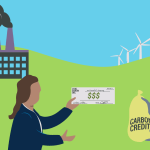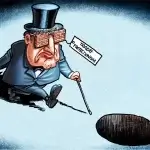The Invisible Hand of Carbon: How Trading Shapes Our Lives

From the fuel we pump to the food on our plates, the unseen hand of carbon trading touches nearly every aspect of our lives. While you might not be buying and selling “carbon” at the market, its price dictates the cost of everyday choices, nudging us towards a greener future – sometimes subtly, sometimes with a noticeable shove.
So, how exactly does this intricate system of permits and allowances influence our lifestyles? Let’s delve deeper:
1. The Price Tag on Pollution:
Carbon trading sets a monetary value on greenhouse gas emissions. Polluters, typically industries, receive a cap on their emissions. Exceeding this cap incurs a financial penalty, while staying under allows them to sell unused allowances to others who need them. This creates a market, and where markets exist, prices fluctuate.
Rising carbon prices translate directly to cost increases for polluters. These costs inevitably trickle down to consumers. Electricity bills rise, the price of gasoline creeps up, and even everyday products made with energy-intensive processes carry a bit more weight in your wallet.
2. The Greener Choice, the Cheaper Option:
On the other hand, carbon trading incentivizes cleaner alternatives. Companies that invest in renewable energy or energy-efficient technologies find themselves with surplus allowances, making them sellers in the market. This drives down the price of their cleaner products, making them more competitive against their emissions-heavy counterparts.
For consumers, this can mean opting for energy-efficient appliances or choosing public transportation over personal vehicles, not just for environmental reasons, but because it makes financial sense. It’s a subtle shift, but one that nudges us towards a lower-carbon footprint, one purchase at a time.
3. Beyond the Market: A Ripple Effect:
The impact of carbon trading extends beyond individual choices. As industries face pressure to reduce emissions, they are forced to innovate. This spurs the development of clean technologies, renewable energy sources, and more efficient production processes. These advancements then benefit society as a whole, driving down the overall cost of clean energy and making it more accessible to everyone.
However, it’s not all sunshine and roses. Critics argue that carbon trading can disproportionately burden low-income communities who are already struggling with rising costs. Additionally, the effectiveness of the system relies heavily on robust regulations and fair market practices, which are not always easy to achieve.
The Road Ahead:
Carbon trading is not a silver bullet, but it is a powerful tool in the fight against climate change. It nudges us towards greener choices, incentivizes cleaner technologies, and sends a clear message: polluting has a price. As the system evolves, it’s crucial to address its shortcomings and ensure its benefits are equitably shared. Ultimately, carbon trading can pave the way for a future where a lower-carbon lifestyle isn’t just a personal choice, but a reality driven by economics and innovation.
So, the next time you fill up your car or flip on the lights, remember, the invisible hand of carbon trading is at work, shaping not just the environment, but the choices we make every day. Will we choose the greener path, or will we pay the price of inaction? The answer lies in our hands, guided by the invisible market forces of carbon.









